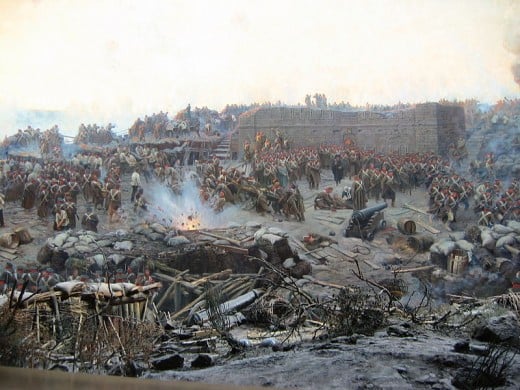- HubPages»
- Education and Science»
- History & Archaeology»
- History of the Modern Era
European History: The Crimean War
The Crimean War: A Summary
Where Is The Crimea?
Background
By the mid eighteenth century, the Ottoman Empire was in serious decline. Moreover, the rise of the Russian power in the Crimean region increasingly worried the major powers of Europe, including Britain and France.
The Russo-Turkish War in 1768-74 led to Crimean independence and Russian gains at the expense of the Ottomans along the Black Sea. Under the peace treaty the tsar became protector of Orthodox Christians within the Ottoman Empire. Russia annexed the Crimean region in 1783.
Further wars between Russians and Ottomans in 1787-92 and 1806-12 saw more territory ceded to Russia. Serbia gained autonomy from Ottoman rule in 1817, as did the Danubian provinces of Moldavia and Wallachia in 1829 after Russian intervention.
Since 1774 Russia had regarded itself as the protector of Christian Orthodoxy in the Ottoman Empire. In 1852 the Ottoman Sultan allowed French Catholic monks to protect the holy places in Jerusalem, which was under Ottoman control at the time. The Russian objected and occupied the Danubian provinces in 1853.
A Hussar's Hackle

The First Shots Of War
The first shots of the Crimean War were in November 1853 when the Russian navy, making good use of its new Paixhans naval guns firing explosive shells, sailed across the Black Sea and destroyed the Ottoman fleet at Sinope, northern Turkey. Faced with this threat to the Ottoman Empire and alarmed by possible Russian expansion towards the Mediterranean, Britain and France declared war in March 1854. They were joined by the Italian state of Piedmont, which was anxious to gain French support for its campaign to unite Italy.
The Siege Of Sevastopol

Cavalry Charges
The battle of Balaclava was distinguished by three cavalry charges. A Russian charge towards Balaclava was met by the 'Thin Red Line,' two rows of British infantry from the 93rd (Highland) Regiment who stopped the charge with three volleys. Another Russian cavalry advance was repelled by the British Heavy Cavalry Brigade, charging uphill against advised military practice. The British Light Cavalry Brigade then misunderstood its instructions and charged down a valley towards a Russian field battery while coming under fire from Russian guns on either side. This charge of the Light Brigade, up and back down the valley, is seen as one of the most futile actions in military history.
The Horrors Of War
"For all I can observe, these men die without the least effort being made to save them.'
William Howard Russell, reporter for 'The Times,' 1855
Capture Of Malakoff

Far From Home
The British and French forces faced considerable logistical problems in marshalling troops and supplies so far from home. Assembling at Varna on the Bulgarian coast, the Allies ferried troops across the Black Sea to Crimea with the aim of capturing the naval fortress of Sevastopol and nullifying Russian naval power in the region. The French army included many troops hardened in campaigns in North Africa and was generally better organised than the British, who were fighting their first European war since 1815. The British commander-in-chief, Lord Raglan, had never commanded a unit larger than a battalion and had no experience of modern warfare despite being 66 years old. To make matters worse, his troops had been ravaged by cholera, and were poorly trained and badly equipped.
The Allies landed in the west of the Crimea and advanced south towards Sevastopol. They first encountered the Russian army dug in on the Alma River. On the 20th September 1854 the Allies crossed the river but the British then faced the Russians at the top of a steep slope. British casualties were high, but poor leadership and inferior firearms forced the Russians to retreat. The Allies then advanced to within sight of Sevastopol. The Russians blocked the entrance to the harbour, forcing the Allies to besiege the port from the land. Had the Allies arrived sooner, they might have taken their target at once, as the Russians had only just completed its defences. But by the date of the attack, on the 17th October 1854, the Russians were secretly fortified against the Allied bombardment.
In an attempt to break the siege, Russian forces advanced towards the Allied base at Balaclava. A battle took place on the hills above the port on the 25th October, a contest distinguished only by its cavalry charges. In the third major battle of the campaign, the Allies managed to occupy an undefended ridge at the town of Inkerman, which commanded the approaches to Sevastopol, and from here held off repeated Russian attacks on the 5th November. Casualties were high on both sides and the result of the battle was inconclusive. British and French troops were forced to dig in as the siege was set to continue through the winter. The Allies were unprepared for the freezing conditions, with inadequate food, fuel, and clothing supplies. British troops suffered the worst. Without proper shelter and provisions they were soon impaired by malnutrition and cholera. Conditions became so desperate that they were reduced to only 12,000 fit men. Critical reports of the situation were sent back to London by The Times correspondent William Howard Russell, considered to be one of the first war correspondents. These led to the fall of the government and a swift improvement in supply. After the war the British introduced wartime censorship of the press to prevent such stories appearing again.
Spring brought a renewal of the bombardment of Sevastopol. By July the Russians were suffering daily losses of almost 350 men, but held out until the 8th September when the French, in the one perfectly planned and executed operation of the war, captured the vital bastion of Malakoff, which overlooked the city. That night the Russians destroyed Sevastopol defences before evacuating the southern part of the city.
Fighting also took place in the Baltic Sea, where a Franco-British fleet bombarded Russian positions, and threatened St. Petersburg, the Russian capital. But this theatre of operations reached a stalemate early on in the war as the Russian fleet was too small to be effective, while the British and French believed that the Russian coastal fortifications were too strong to take on.
The Charge Of The Light Brigade On Film
Peace And Consequences
By the time Sevastopol fell in September 1855, Russia's new tsar Alexander II was anxious to make peace. By the 1856 Treaty of Paris, Russia recognised the territorial integrity of the Ottoman Empire, and give up its guardianship of Orthodox Christians in the Empire, but ultimately its dominant role in the Balkans was only temporarily reduced. The Ottoman Empire, while remaining intact, continued to decline.
The Angel Of The Crimea

Aftermath
Despite its defeat in the Crimea, Russia' Empire continued to expand, conquering the northern Caucasus in 1864 and gaining control over the central Asian khanates (chieftains) by 1884.
War between the Ottoman and Russian Empires broke out again after the Ottomans suppressed a rebellion in Bulgaria in 1876. Russia supported Bulgaria and declared war in 1877. The Sultan made peace in March 1878; the Treaty of San Stefano, which established the independence of Serbia and Romania, and set up a Bulgarian state. Alarmed by the creation of this large pro-Russian state, the other European powers met in Berlin in July, cutting Bulgaria down in size and returning Macedonia to Ottoman. The Balkan dissatisfaction with this deal led to further wars in the early 20th century.
In Britain Edward Cardwell, Secretary of State for War, abolished the purchase of commissions, introduced short service as the basis of enlistment, and set up an army reserve force. Under Florence Nightingale's direction, army military medical care was properly organised.
The Present Crimean Crisis
- BBC News - Ukraine crisis
Everything you need to know about the present troubles gripping the Crimean region, that was until recently, an autonomous area of the Ukraine, but has been occupied by Russian forces since the beginning of March 2014.
The Possibility Of Another Crimean War?
Will the Crimean crisis erupt into a full blown war?
© 2014 James Kenny









